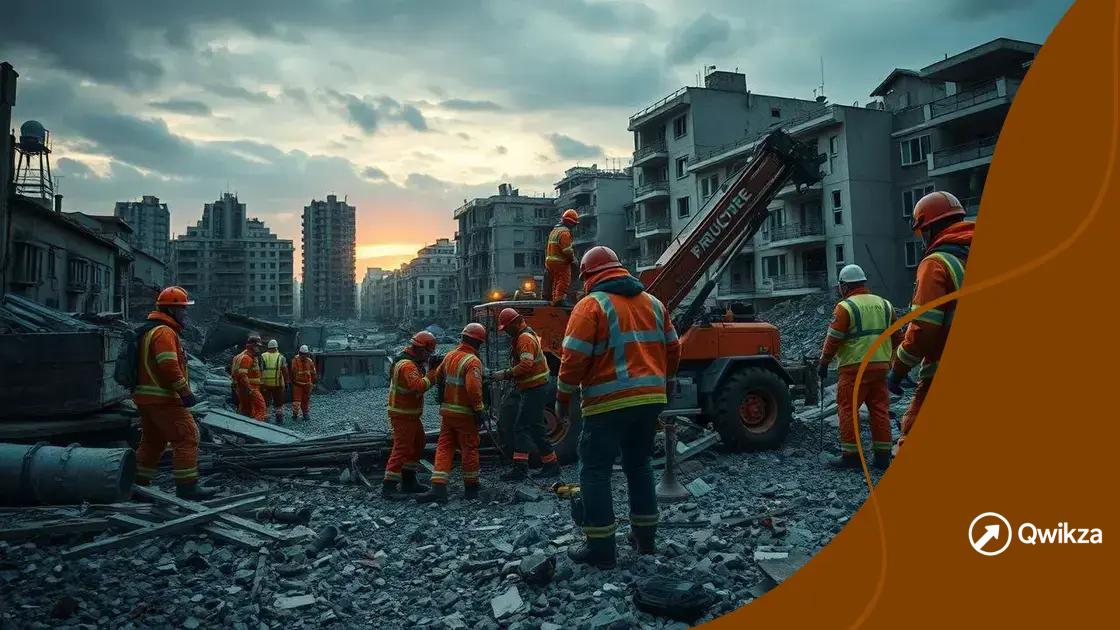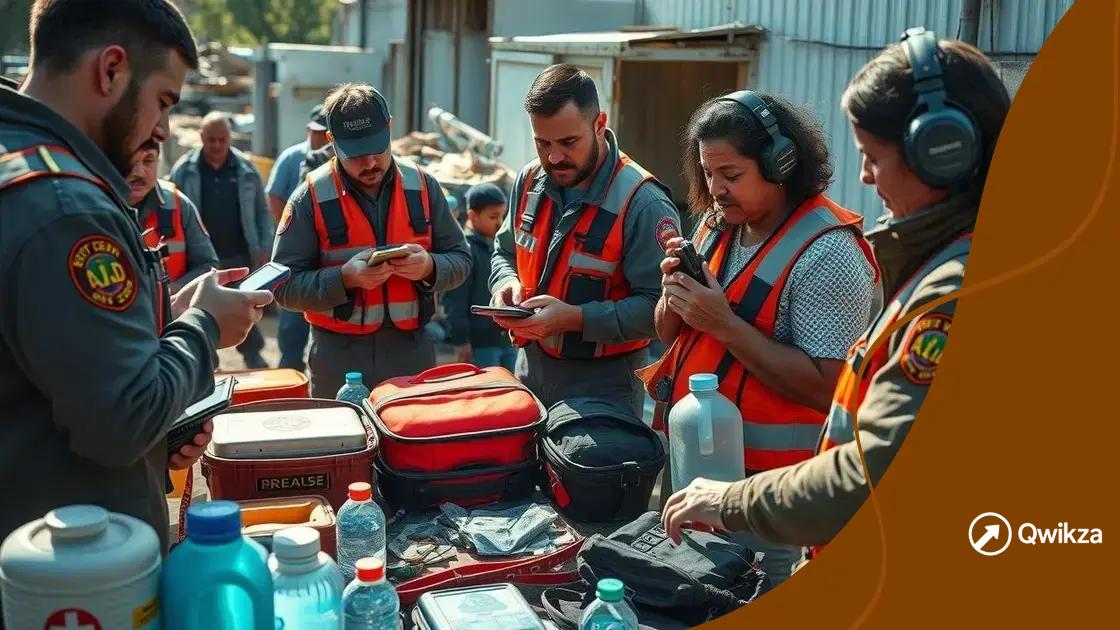Natural disasters and federal response: what’s next?

Natural disasters and federal response involve coordinated efforts by government agencies to provide funding, resources, and support, enhancing community resilience and effective disaster management.
Natural disasters and federal response play a pivotal role in shaping how communities recover after catastrophic events. Have you ever wondered how federal actions influence local rebuilding? In this article, we’ll explore the mechanisms of federal aid and its importance during crises.
Understanding federal response to natural disasters
Understanding how federal response to natural disasters works is crucial for recovery efforts. During times of crisis, the federal government plays a vital role in coordinating resources and support. This article explores the mechanisms involved in federal responses and how they affect local communities.
Types of Federal Assistance
The federal response to natural disasters includes various forms of assistance, each tailored to meet specific needs.
- Financial aid through grants and loans
- Emergency services and personnel deployment
- Technical support for local agencies
- Long-term recovery planning assistance
These programs often help stabilize the affected regions quickly, allowing communities to rebuild. In addition to financial assistance, the federal government provides logistical support, ensuring that supplies and services reach those in need.
Agencies Involved in the Response
Several federal agencies collaborate during disaster management. Prominent among them are:
- FEMA (Federal Emergency Management Agency)
- NOAA (National Oceanic and Atmospheric Administration)
- Department of Homeland Security
- Department of Health and Human Services
These agencies coordinate their efforts to ensure effective disaster response. For instance, FEMA mobilizes resources and implements recovery programs, while NOAA monitors weather conditions and issues warnings.
It’s also important to recognize the role state and local governments play in the response. They often serve as first responders and facilitate communication between the federal government and affected communities. This partnership is crucial for an effective disaster response.
Challenges in Federal Response
Despite well-structured plans, challenges often arise during federal response to natural disasters. Delays in funding disbursement can hinder recovery efforts, as can bureaucratic red tape. Additionally, ensuring that assistance reaches marginalized groups can be difficult.
Effective communication is another challenge. Communities may not fully understand the resources available to them or how to access them. Ongoing outreach and education are essential to bridge this gap and help communities prepare for future crises.
In summary, the federal response to natural disasters involves a complex interplay of agencies, resources, and strategies. By understanding these components, communities can better navigate recovery processes and enhance their resilience to future disasters.
Impact of federal funding on recovery efforts
The impact of federal funding on recovery efforts after natural disasters is significant. This support can determine how quickly and effectively a community can rebound. Understanding how these funds are allocated and managed is crucial for affected areas.
Types of Federal Funding
Federal funding comes in various forms, each serving different needs during the recovery process.
- Grants for rebuilding infrastructure
- Low-interest loans for businesses
- Financial aid for affected individuals
- Funding for emergency preparedness programs
These resources are designed to help communities rebuild in a way that is resilient to future disasters. The direct financial support from federal grants can help restore essential services, such as water, power, and transportation systems.
Effects on Local Economies
When federal funding flows into a community, local economies often see a boost. Jobs are created in construction, service industries, and local businesses. This influx of money can revitalize areas that suffered extensive damage.
Moreover, quick access to federal funding can prevent long-term economic decline. Communities that receive timely financial support are more likely to recover faster, reducing the risk of increased unemployment and business closures.
Challenges in Distribution
Despite the benefits of federal funding, challenges can arise during its distribution. Bureaucracy can slow down the allocation of funds, delaying necessary assistance. Understanding the application process and meeting eligibility requirements is essential for local governments and organizations.
Furthermore, communities must ensure they are fully informed about available resources to leverage all possible support effectively. This may involve outreach efforts that educate residents and local leaders about how to navigate federal programs.
In summary, the impact of federal funding on recovery efforts is critical. It not only aids in physical rebuilding but also boosts the economic stability of communities facing the aftermath of natural disasters.
Role of emergency management agencies

The role of emergency management agencies is critical during natural disasters. These organizations work to coordinate responses and implement recovery efforts effectively. Their involvement is essential for ensuring that communities receive the help they need in a timely manner.
Key Functions of Emergency Management Agencies
Emergency management agencies perform several vital functions, including:
- Preparing and planning for potential disasters
- Coordinating with local, state, and federal resources
- Communicating effectively with the public and media
- Assessing damage and needs after a disaster strikes
Through preparation and planning, these agencies help communities develop strategies to reduce risks. They also play a crucial role in training local responders to handle emergencies efficiently.
Collaboration with Other Entities
Emergency management agencies collaborate with numerous local and federal organizations. They work closely with agencies like FEMA, the Red Cross, and public health departments. This teamwork ensures that everyone is on the same page during a disaster response.
In times of need, these agencies mobilize quickly. For example, they coordinate the deployment of rescue and recovery teams, working to restore services and provide necessary resources to affected areas. Their ability to foster collaboration is vital for an effective response.
Community Engagement and Education
Engaging with the community is another essential role of emergency management agencies. They conduct educational programs to inform residents about safety measures and disaster preparedness. These initiatives empower individuals and families to be more self-sufficient during emergencies.
By promoting community involvement, these agencies foster resilience among residents. This engagement can reduce panic and confusion, allowing for smoother evacuation and recovery processes. Understanding how to respond during disasters can significantly save lives.
Overall, the role of emergency management agencies is multifaceted and indispensable. Their preparation, coordination, and community engagement efforts are vital for effective disaster response and recovery.
Community involvement in disaster response
Community involvement in disaster response is essential for effective recovery. When disasters strike, local residents often become the first line of support. They understand their community’s needs and can act quickly to help others.
The Importance of Local Volunteers
Local volunteers play a crucial role during emergencies. Their knowledge of the area makes them invaluable in assessing damage and delivering aid. In many cases, communities organize volunteer groups to coordinate these efforts.
- Setting up temporary shelters
- Distributing food and water
- Providing medical assistance
- Connecting families with resources
These grassroots initiatives can significantly speed up recovery times, as volunteers mobilize to assist their neighbors while formal assistance is still being arranged. Their unity can foster resilience and hope.
Building Preparedness through Engagement
Engaging with community members before a disaster strikes can also enhance preparedness. Local organizations often run training sessions and drills to educate residents on what to do in an emergency. This proactive approach creates a sense of ownership and readiness.
By participating in these activities, community members learn how to respond effectively. They can share this knowledge with their families and neighbors, further strengthening their network of support.
Collaboration with Local Agencies
Collaboration between residents and local agencies is vital for disaster response. Emergency management agencies often work alongside community groups to develop response plans that reflect the needs of the community. This partnership ensures that resources are allocated where they are most needed.
Through community meetings and outreach, local leaders can gather feedback and suggestions, making the response efforts more inclusive. This level of participation can significantly enhance the overall effectiveness of recovery operations.
Ultimately, community involvement in disaster response not only provides immediate assistance but also cultivates resilience. By working together, residents build a stronger and more prepared community.
Lessons learned from past natural disasters
Lessons learned from past natural disasters can shape future responses and improve preparedness. Each event provides valuable insights into what works and what does not during a crisis. Analyzing these experiences helps communities become more resilient.
Key Takeaways from Recent Disasters
By studying recent disasters, we can identify common themes and areas for improvement. Some important lessons include:
- The importance of timely communication during a crisis
- Effective coordination among local, state, and federal agencies
- The need for clear evacuation plans and routes
- The critical role of community volunteers in response efforts
These insights can guide how local governments and agencies prepare for future events. For instance, better communication strategies can help keep residents informed and safe during emergencies.
Building Resilient Infrastructure
Another lesson is the necessity of building infrastructure that can withstand disasters. Many areas learned the hard way that poorly designed buildings and roads can lead to more significant damage and prolonged recovery periods.
Investing in resilient infrastructure not only protects lives but also speeds up recovery. Communities should aim to implement building codes that prioritize safety and durability in their planning.
Psychological Preparedness
Understanding the emotional impact of disasters is another crucial lesson. Past disasters have shown that providing mental health support to affected individuals can aid recovery. It is essential to address the psychological needs of residents alongside physical rebuilding.
Preparedness training should include segments on mental health resources to ensure communities are ready to support each other during crises. This approach fosters collective resilience and well-being.
In conclusion, the lessons learned from past natural disasters are invaluable. They inform better practices that can lead to improved responses and stronger communities in the face of future challenges.
FAQ – Frequently Asked Questions about natural disasters and federal response
What is the role of federal agencies during natural disasters?
Federal agencies coordinate disaster response, providing funding, resources, and support to state and local governments.
How can communities prepare for future disasters?
Communities can prepare by creating emergency plans, conducting training sessions, and educating residents on safety measures.
What lessons have been learned from past natural disasters?
Key lessons include the importance of communication, collaboration, and the need for resilient infrastructure.
Why is community involvement essential in disaster response?
Community involvement provides local knowledge, quick support, and fosters resilience, making recovery efforts more effective.
